As much as we love PRINCE2®, we will admit that the PRINCE2 manual can be a bit dry!
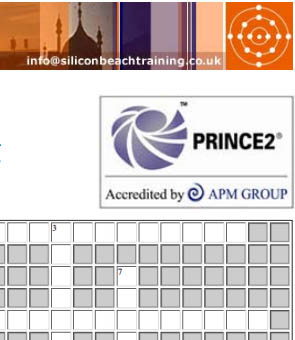 We've put together a PRINCE2 Crossword to Download to help enliven your revision a bit!
We've put together a PRINCE2 Crossword to Download to help enliven your revision a bit!
BEFORE YOU COMPLETE THE CROSSWORD: Read through the statements in this PRINCE2 Crossword Revision post.
You can also download the solution to check your answers at the bottom of the revision post (but no cheating please)!!
We're committed to making learning PRINCE2 as easy and enjoyable as possible - so before you attend one of our PRINCE2 courses we provide a comprehensive pre-course workbook which contains loads of quizzes and guidance to make preparing for the course as interactive as we can.
Why not also try our Interactive PRINCE2 Quiz (you'll need Flash for this).
Andy Trainer
15 Jul 2011
PRINCE2® PROCESSES – Starting Up a Project (SU)
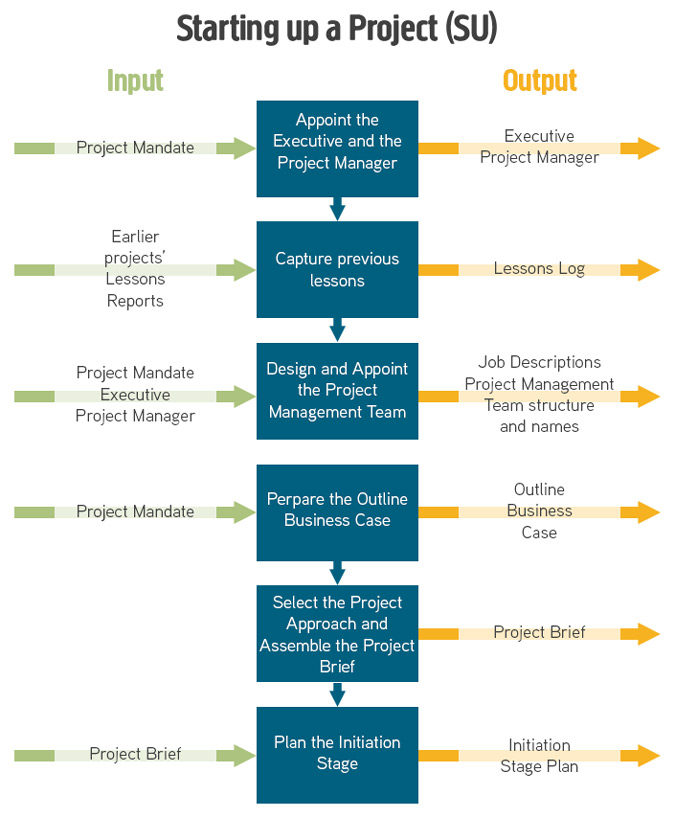
The purpose of the Starting up a Project process is to ensure that the prerequisites for Initiating a Project are in place by answering the question: do we have a viable and worthwhile project?
This process is triggered by a mandate and is designed to establish the following:
- There is a business justification for initiating the project (documented in an outline Business Case)
- All the necessary authorities exist for initiating the project
- Sufficient information is available to define and confirm the scope of the project (in the form of a Project Brief)
- The various ways the project can be delivered are evaluated and a project approach selected
- Individuals are appointed who will undertake the work required in project initiation and/or will take significant project management roles in the project
- The work required for project initiation is planned (documented in a Stage Plan)
- Time is not wasted initiating a project based on unsound assumptions regarding the project’s scope, time scales, acceptance criteria, and constraints.
Products produced during this process are as follows:
- Role descriptions
- Daily Log
- Lessons Log
- Outline Business Case
- Project Product Description
- Project Approach
- Project Brief
- Stage Plan
The PRINCE2 processes are covered in detail in our PRINCE2 Foundation training and PRINCE2 Practitioner training courses in Brighton, Sussex.
Andy Trainer
12 Jul 2007
PRINCE2® PROCESSES – Closing a Project (CP)
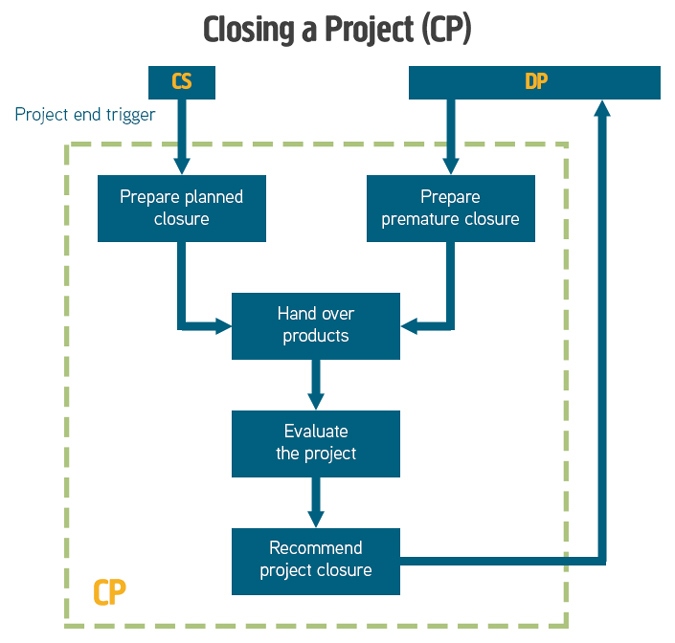
See our courses for PRINCE2.
The purpose of the Closing a Project process is to provide a fixed point at which acceptance for the project product is confirmed and to recognize that objectives set out in the original Project Initiation Documentation have been achieved (or approved changes to the objectives have been achieved), or that the project has nothing more to contribute.
The objective of the Closing a Project process is to:
- Verify user acceptance of the project’s products
- Ensure that the host site is able to support the products when the project is disbanded
- Review the performance of the project against its baselines
- Assess any benefits that have already been realized, update the forecast of the remaining benefits, and plan for a review of those unrealized benefits
- Ensure that provision has been made to address all open issues and risks, with follow-on action recommendations.
The main products of this process are as follows:
- Project Plan updated with final actual
- Product Status Account covering the status of all products for the project
- Issue register to identify any outstanding issues
- Follow-on action recommendations created with any outstanding issues to be addressed
- Configuration item records updated with current status of products
- Benefits review plan updated with dates for benefits realization
- Acceptance records for products completed
- End project report created
- Lessons Report created
- Close Issue, Risk, Quality registers, Daily and Lessons Log
Andy Trainer
12 Jul 2007
PRINCE2® PROCESSES – Closing a Project (CP)

See our courses for PRINCE2.
The purpose of the Closing a Project process is to provide a fixed point at which acceptance for the project product is confirmed and to recognize that objectives set out in the original Project Initiation Documentation have been achieved (or approved changes to the objectives have been achieved), or that the project has nothing more to contribute.
The objective of the Closing a Project process is to:
- Verify user acceptance of the project’s products
- Ensure that the host site is able to support the products when the project is disbanded
- Review the performance of the project against its baselines
- Assess any benefits that have already been realized, update the forecast of the remaining benefits, and plan for a review of those unrealized benefits
- Ensure that provision has been made to address all open issues and risks, with follow-on action recommendations.
The main products of this process are as follows:
- Project Plan updated with final actual
- Product Status Account covering the status of all products for the project
- Issue register to identify any outstanding issues
- Follow-on action recommendations created with any outstanding issues to be addressed
- Configuration item records updated with current status of products
- Benefits review plan updated with dates for benefits realization
- Acceptance records for products completed
- End project report created
- Lessons Report created
- Close Issue, Risk, Quality registers, Daily and Lessons Log
Andy Trainer
12 Jul 2007
PRINCE2® PROCESSES – Managing Product Delivery (MP)
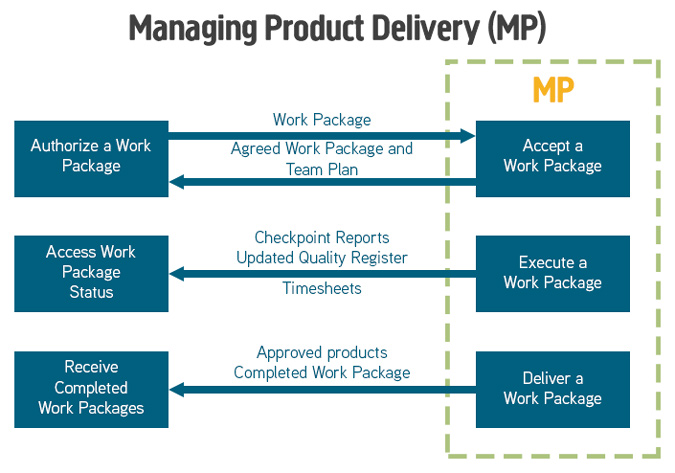
The purpose of the Managing Product Delivery process is to control the link between the Project Manager and the Team Manager(s), by placing formal requirements on accepting, executing and delivering project work.
The role of the Team Manager(s) is to coordinate an area of work that will deliver one or more of the project’s products. They can be internal or external to the customer’s organisation.
The objective of the Managing Product Delivery process is to ensure that:
- Work on products allocated to the team is authorised and agreed.
- Team Managers, team members and suppliers are clear as to what is to be produced and what is the expected effort, cost or timescales.
- The planned products are delivered to expectations and within tolerance.
- Accurate progress information is provided to the Project Manager at an agreed frequency to ensure that expectations are managed.
Products that are created or updated during this process are:
- Team plans with actual dates.
- Risk register with any identified work package level risks.
- Quality register with all quality work that is being undertaken.
- Configuration Item Records with the latest status of products produced.
- Project Issues with status information and impact analysis for current or new issues identified.
- Checkpoint Reports providing regular progress information to the Project Manager.
Silicon Beach Training is an accredited training organisation for PRINCE2 Training.
Andy Trainer
12 Jul 2007
PRINCE2® PROCESSES – Managing Product Delivery (MP)

The purpose of the Managing Product Delivery process is to control the link between the Project Manager and the Team Manager(s), by placing formal requirements on accepting, executing and delivering project work.
The role of the Team Manager(s) is to coordinate an area of work that will deliver one or more of the project’s products. They can be internal or external to the customer’s organisation.
The objective of the Managing Product Delivery process is to ensure that:
- Work on products allocated to the team is authorised and agreed.
- Team Managers, team members and suppliers are clear as to what is to be produced and what is the expected effort, cost or timescales.
- The planned products are delivered to expectations and within tolerance.
- Accurate progress information is provided to the Project Manager at an agreed frequency to ensure that expectations are managed.
Products that are created or updated during this process are:
- Team plans with actual dates.
- Risk register with any identified work package level risks.
- Quality register with all quality work that is being undertaken.
- Configuration Item Records with the latest status of products produced.
- Project Issues with status information and impact analysis for current or new issues identified.
- Checkpoint Reports providing regular progress information to the Project Manager.
Silicon Beach Training is an accredited training organisation for PRINCE2 Training.
Andy Trainer
12 Jul 2007
PRINCE2® PROCESSES – Controlling a Stage (CS)
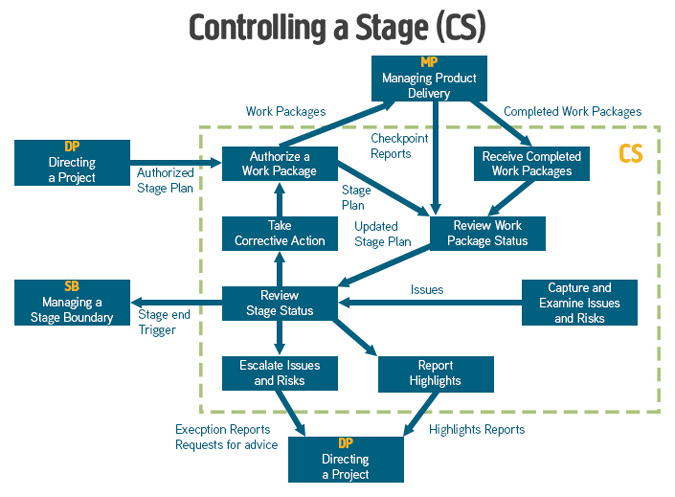
The purpose of the Controlling a Stage process is to assign work to be done, monitor such work, deal with issues, report progress to the Project Board, and take corrective actions to ensure that the stage remains within tolerance.
For each stage, the following cycle of activities will be covered:
- Authorise a Work Package
- Review Work Package Status
- Receive Completed Work Packages
- Review the stage status
- Report highlights
- Capture and examine issues and risks
- Escalate issues and risks
- Take correction action
The continued assessment of risk and issues during this process is important.
Products used or produced during this process:
- Work packages, detailing the products to be produced must be agreed between Project and Team Manager.
- Quality register – checked for approved products produced
- Configuration item records – updated with the latest status of products
- Checkpoint reports – reviewed in preparation for Highlight reports
- Highlight Reports (time-driven control) produced by the Project Manager, sent to the Project Board advising on progress information.
- Issue reports and Issues register in which all issues are captured and examined.
- Daily log – used to informally manage any risks and issues
- Lessons Log – updated with any lessons learned during the stage
- Updated Risk register.
- The Stage Plan which is regularly updated with actual achievements.
- An Exception Report may also need to be created if an issue is forecast to exceed stage tolerances.
Learn more about the Controlling a Stage Process on our PRINCE2 Courses.
Andy Trainer
12 Jul 2007
PRINCE2® PROCESSES – Controlling a Stage (CS)

The purpose of the Controlling a Stage process is to assign work to be done, monitor such work, deal with issues, report progress to the Project Board, and take corrective actions to ensure that the stage remains within tolerance.
For each stage, the following cycle of activities will be covered:
- Authorise a Work Package
- Review Work Package Status
- Receive Completed Work Packages
- Review the stage status
- Report highlights
- Capture and examine issues and risks
- Escalate issues and risks
- Take correction action
The continued assessment of risk and issues during this process is important.
Products used or produced during this process:
- Work packages, detailing the products to be produced must be agreed between Project and Team Manager.
- Quality register – checked for approved products produced
- Configuration item records – updated with the latest status of products
- Checkpoint reports – reviewed in preparation for Highlight reports
- Highlight Reports (time-driven control) produced by the Project Manager, sent to the Project Board advising on progress information.
- Issue reports and Issues register in which all issues are captured and examined.
- Daily log – used to informally manage any risks and issues
- Lessons Log – updated with any lessons learned during the stage
- Updated Risk register.
- The Stage Plan which is regularly updated with actual achievements.
- An Exception Report may also need to be created if an issue is forecast to exceed stage tolerances.
Learn more about the Controlling a Stage Process on our PRINCE2 Courses.
Andy Trainer
12 Jul 2007